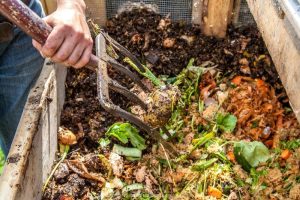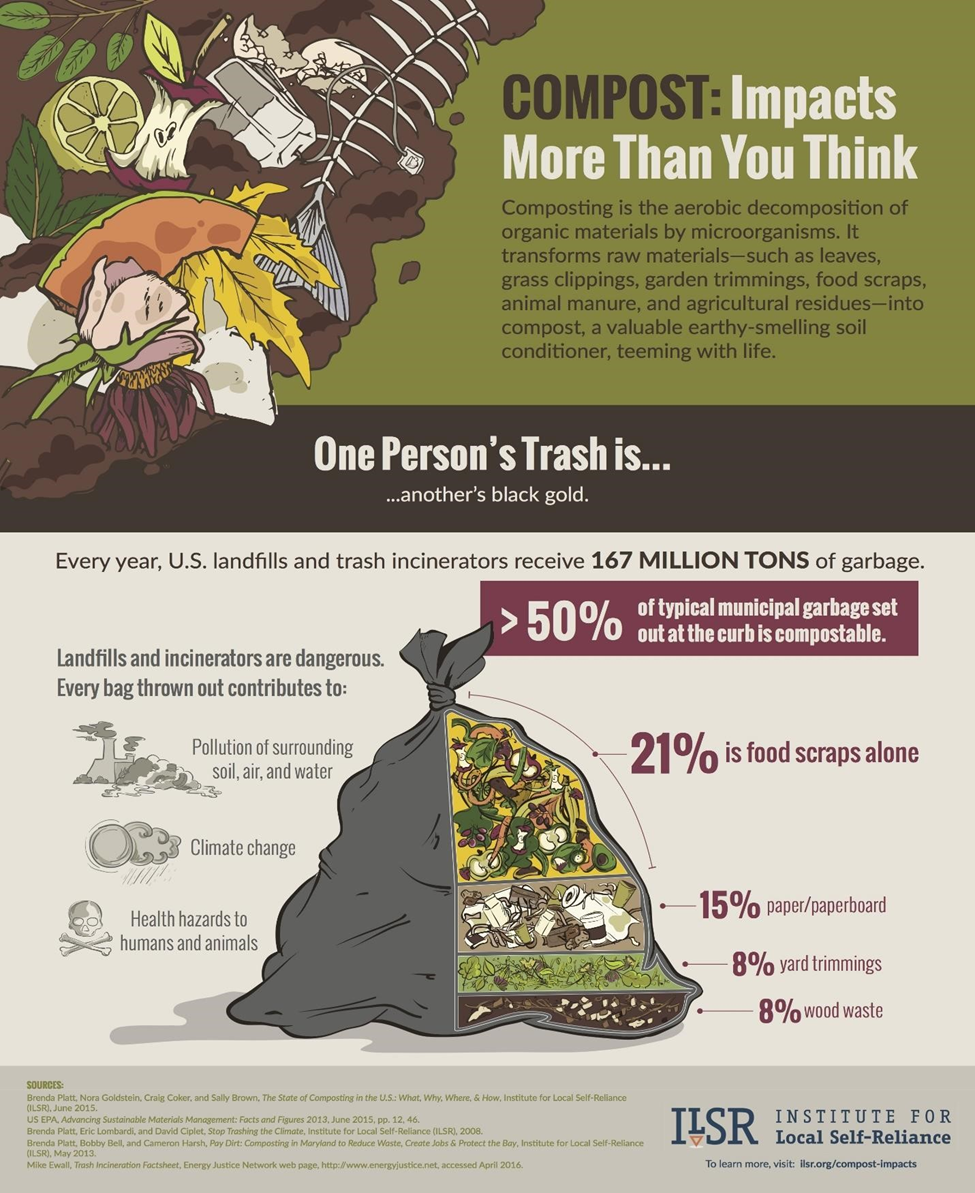
Authored by the Somerville Environmental Commission of Somerville, New Jersey
What is it?
Compost is organic material that can be added to soil to help plants grow. Food scraps and yard waste together currently make up more than 28% of what we throw away, and composting turns them into plant, tree and garden food! Making compost keeps these materials out of landfills and is easy to make inside or outside your home.
Why do it? And how is it beneficial?
There are many benefits that start right away and grow as you put more effort into it.
Compost:
- Enriches soil, helping to retain moisture and suppress plant diseases and pests
- Reduces methane emissions from landfills and lowers your carbon footprint
- Is lawn and garden insurance, moderating soil chemistry and can be applied at any time
- Reduces or eliminates the need for chemical fertilizer
How do I start?
First: pick a place you want to put all your materials. It can be a spot outside on soil, patio, or walkway for larger piles; or inside for worm composting on a kitchen cabinet, basement or in a room.
Next: figure out what ingredients you can gather and in what type of bin you plan to put them all together.
What ingredients do I need?
This is the easy part because you can find them everywhere! There are 4 main ingredients to a great compost pile:
- “Brown” materials: Dry leaves, pine needles, sawdust or wood shavings, paper, straw, twigs, dryer and vacuum cleaner lint, and dry vegetable stalks like corncobs and leaves. These are high in carbon.
- “Green” materials: Coffee grounds and tea bags, kitchen scraps such as eggshells, fruit and veggie waste, potato peelings, fresh outdoor material like grass clippings, leaves or weeds, feather or hair, and other moist green matter. These are high in nitrogen.
- Water. Some, but not too much. A good rule of thumb is to keep your compost pile as moist as a well-wrung sponge. Using an enclosed container or tarp covering will make it easy to keep the right moisture level.
- Air. This is important for outdoor composting. The microorganisms that do all the work require a lot of oxygen. When you first put a pile together, there’s probably plenty of air and oxygen. But as the microorganisms get started, they will consume this oxygen and you need to turn or aerate your compost pile to keep them working at their best.
How do I get a Composting Bin?
There are several ways to make or buy them. After a small upfront investment of time and resources, it’s simple and easy. Also consider “upcycling” some old materials that are just lying around. Here are a few different ways you can make it at home:
- Create a bin in your yard. You can make one using wire, a modified trash can, blocks, bricks or stone, wood pallets, or with wood. Find a book, search the internet, or ask a gardening expert for tips and how-to’s.
- Purchase a bin for outside. There are several kinds, including stationary or tumbling bins that allow you make batches or continuous amounts of compost. You can find them at a store, online, or a gardening center.
- Purchase or create a bin for indoors. Also known as worm composting, these watertight bins fit on a countertop or side table and need only kitchen scraps, a handful of worms and a stable temperature of about 50oF – 80oF to get going. The castings worms create is just as (or even more!) beneficial as other types of compost.

Recipes and tips
All organic matter breaks down eventually, no matter what you do. If you simply use about 3 times as much “brown” materials as “green” materials, you’ll be off to a great start.
When making compost, your job is to provide the best possible environment for these beneficial organisms to do their work. If you do so, the decomposition process works very rapidly—sometimes in as little as four weeks. If you don’t provide the optimum environment, decomposition will still happen but will take longer.
Sample recipes
Recipe 1 – Spread the ingredients in 3-inch-deep layers to a height of 3 to 4 feet.
- 1 part fresh grass clippings
- 1 part dry leaves
- 1 part good garden soil
Recipe 2 – Spread ingredient in 4-inch layers, adding water if needed.
- 2 parts fresh glass clippings
- 2 parts straw or spoiled hay
- 1 part good garden soil
Recipe 3 – Spread ingredient in 4-inch layers, adding water if needed.
- 2 parts dry leaves
- 1 part fresh grass clippings
- 1 part food scraps
Advanced: Ingredients to help spice up your compost pile
Sprinkle onto your compost pile as you build each layer to add important nutrients and help speed up the composting process:
- “Compost Starter” applied at the rate on the package. Purchase it at stores and gardening centers
- Garden soil or finished compost (high in microorganisms), 1/2 shovelful on each layer
- Bone meal, blood meal, or alfalfa meal (high in nitrogen), 1/2 shovelful on each layer
- Fish waste or manure (high in nitrogen), a shovelful on each layer
- Wood stove or fireplace ashes (high in potash and carbon), a shovelful on each layer
- Crushed rock dust (rich in minerals/feeds microbes), a shovelful on each layer
Where do I put it when its ready?
Compost can be applied at any time and in any amount. You can’t really over-apply it. Here are a couple of suggested places:
- In the vegetable garden. Apply in the spring, mixing in the top few inches of soil or around individual plants, being careful to keep it away from the stems to prevent rot.
- For perennials. At any time, put a 1-inch layer around the base of each plant, keeping away from stems.
- Shrubs and trees. Spring and fall spread 3-inches in a wide band beyond the canopy. Keep 6 inches away from stems and trunks.
- Flower bulbs. Mix in each bulb planting hole or prepare an entire bed of it.
- Lawns. Apply 1/2-inch over your entire lawn in the spring and fall. If the soil is compacted, aerate first so water will wash the compost down into the grass roots.
Anything else to know?
Not all ingredients are good for composting! Avoid putting these in your pile:
- Dairy products, meat and scraps, fish bones, and fats/grease/oils
- Coal or charcoal ash
- Pet waste
- Yard trimmings treated with chemical pesticides
- Diseased or insect-ridden plants
- Black walnut tree leaves or twigs (can be harmful to plants)
What is my compost pile doing?
Fun facts about compost:
- Compost gets hot! It can get well over 100oF, even as hot as the inside of a car sitting in the summer sun. Why? Different microbes digest materials and give off heat. This helps further breakdown and sterilize the materials.
- It’s smelly! Microbes and tiny organisms breakdown the materials and give off lots of smells. It’s all natural, but if it’s soggy and very smelly you may have too much “green” material.
- Indoor composting with worms creates castings, which is another way to say poop. Yes, worms are pooping beneficial compost! And no, it doesn’t smell!
- Why is it taking so long? Natural processes take time! Even the ideal mix of ingredients, environment and methods will take weeks to get dark, moist and rich soil. Take a look online or ask a gardening expert for tips on how to manage your compost.
- There’s worms and bugs in my compost! That’s great to hear, and most of them are helpful. If you find worms, roly polys or flies and larvae let them stay. But if you find centipedes or spiders, pluck them out as they’re eating the good bugs!

Text in infographic:
Compost: impacts more than you think
Compost is the aerobic decomposition of organic materials by microorganisms. It transforms raw materials – such as leaves, grass clippings, garden trimmings, food scraps, animal manure, and agricultural residues – into compost, a valuable, earthy-smelling soil conditioner, teeming with life.
One person’s trash… is another’s black gold.
Every year, U.S. landfills and trash incinerators receive 167 million tons of garbage.
50% of typical municipal garbage set out at the curb is compostable.
- 21% is food scraps alone
- 15% paper/paperboard
- 8% yard trimmings
- 8% wood waste
Landfills and incinerators are dangerous. Every bag thrown out contributes to:
- Pollution of surrounding soil, air, and water
- Climate change
- Health hazards to humans and animals
